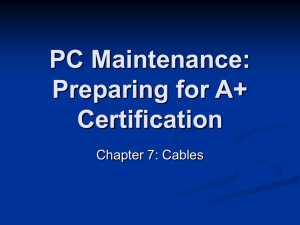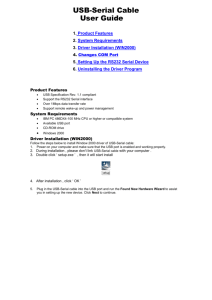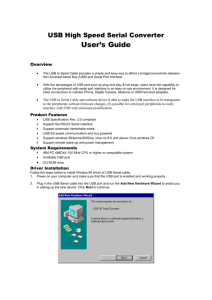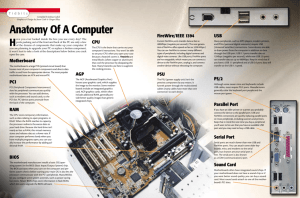TNT - Baltimore City Public School System
advertisement
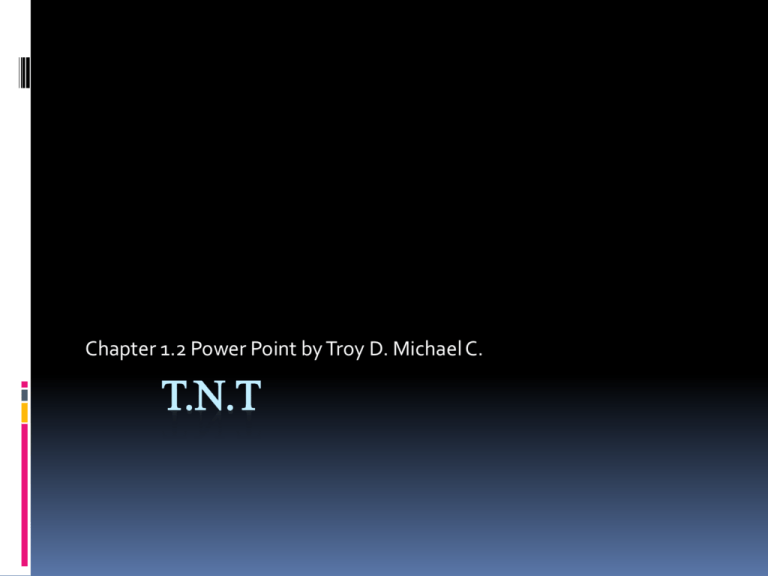
Chapter 1.2 Power Point by Troy D. Michael C. T.N.T I/O Interface ( Sound/Sound Card) Sound Adapters-provides audio capability I/O Interface (Sound/Sound Card) Sound Card I/O Interface (Video/Video Card) Video Card-Provides graphical capability I/O Interface ( Video/Video Card) Video Card I/O Interface (USB 1.1/2.0) USB-Universal Serial Bus (USB) is a standard interface that connects peripheral devices to a computer. It was originally designed to replace serial and parallel connections. USB devices are hot-swappable, which means that users can connect and disconnect the devices while the computer is powered on. USB connections can be found on computers, cameras, printers, scanners, storage devices, and many other electronic devices. A USB hub is used to connect multiple USB devices. I/O Interface ( USB 1.1/2.0) 1.1 USB<allowed transmission rates of up to 12 Mbps in fullspeed mode and 1.5 Mbps in lowspeed mode> 2.0 USB<USB 2.0 allows transmission speeds up to 480 Mbps. USB devices can only transfer data up to the maximum speed allowed by the specific port. > I/O Interface ( Serial/Serial Port) Serial port/Cable-To connect a serial device, such as a modem or printer, a serial cable must be used. A serial cable has a maximum length of 50 feet (15.2 m). I/O Interface (Serial/Serial Port) Serial Port Serial Cable I/O Interface ( IEEE1394/Firewire) Fire Wire-FireWire is a high-speed, hot-swappable interface that connects peripheral devices to a computer. A single FireWire port in a computer can support up to 63 devices. Some devices can also be powered through the FireWire port, eliminating the need for an external power source. FireWire uses the IEEE 1394 standard and is also known as i.Link. IEEE1394-The IEEE 1394a standard supports data rates up to 400 Mbps and cable lengths up to 15 feet (4.5 m). This standard uses a 6-pin connector or a 4-pin connector. The IEEE 1394b standard allows for a greater range of connections, including CAT5 UTP and optical fiber. Depending on the media used, data rates are supported up to 3.2 Gbps over a 100m distance I/O Interface ( IEEE1394/Fire Wire ) Fire Wire IEEE1394 I/O Interface ( Parallel Ports/Cables) Parallel Port-A parallel port on a computer is a standard Type A DB-25 female connector Parallel ports can transmit 8 bits of data at one time and use the IEEE 1284 standard. To connect a parallel device, such as a printer, a parallel cable must be used I/O Interface ( Parallel Port/Cable) Parallel Port Parallel Cable I/O Interface ( NIC) NIC-Network Interface Card(NIC) Connects a computer to a network using a network cable Wireless NIC-Wireless Network Interface Card. Connects a computer to a network using radio frequencies I/O Interface (NIC) NIC(Network Interface Card) Wireless Network Interface Card I/O Interface (Modem/Ports/Cables) Modem-In addition to the serial cable used to connect an external modem to a computer, a telephone cable is used to connect a modem to a telephone outlet. This cable uses an RJ-11 connectorA traditional setup of an external modem using a serial cable and a telephone cable I/O Interface (Modem/Ports/Cables Modem I/O Interface ( PS/2 ports) PS/2- A PS/2 port connects a keyboard or a mouse to a computer. The PS/2 port is a 6-pin mini-DIN female connector. The connectors for the keyboard and mouse are often colored differently, If the ports are not color-coded, look for a small figure of a mouse or keyboard next to each port. I/O Interface ( PS/2 ports) PS/2 Port



